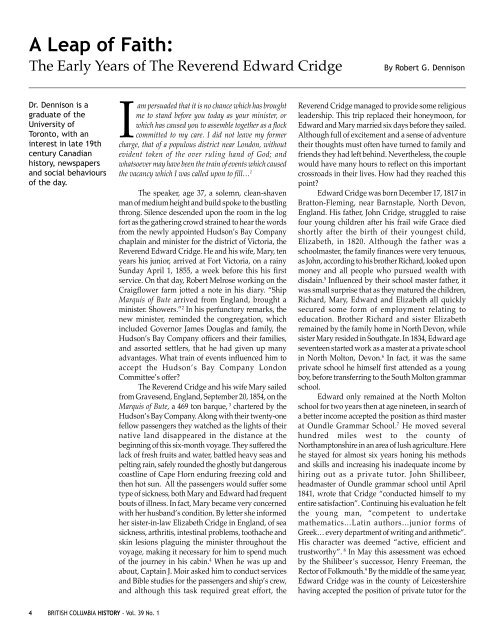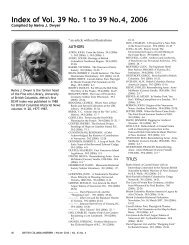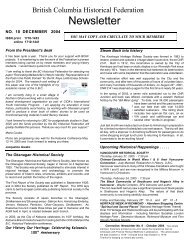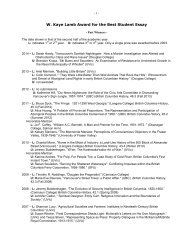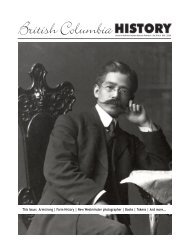bc historic news - BC Historical Federation
bc historic news - BC Historical Federation
bc historic news - BC Historical Federation
You also want an ePaper? Increase the reach of your titles
YUMPU automatically turns print PDFs into web optimized ePapers that Google loves.
A Leap of Faith:The Early Years of The Reverend Edward CridgeBy Robert G. DennisonDr. Dennison is agraduate of theUniversity ofToronto, with aninterest in late 19thcentury Canadianhistory, <strong>news</strong>papersand social behavioursof the day.Iam persuaded that it is no chance which has broughtme to stand before you today as your minister, orwhich has caused you to assemble together as a flockcommitted to my care. I did not leave my formercharge, that of a populous district near London, withoutevident token of the over ruling hand of God; andwhatsoever may have been the train of events which causedthe vacancy which I was called upon to fill… 1The speaker, age 37, a solemn, clean-shavenman of medium height and build spoke to the bustlingthrong. Silence descended upon the room in the logfort as the gathering crowd strained to hear the wordsfrom the newly appointed Hudson’s Bay Companychaplain and minister for the district of Victoria, theReverend Edward Cridge. He and his wife, Mary, tenyears his junior, arrived at Fort Victoria, on a rainySunday April 1, 1855, a week before this his firstservice. On that day, Robert Melrose working on theCraigflower farm jotted a note in his diary. “ShipMarquis of Bute arrived from England, brought aminister. Showers.” 2 In his perfunctory remarks, thenew minister, reminded the congregation, whichincluded Governor James Douglas and family, theHudson’s Bay Company officers and their families,and assorted settlers, that he had given up manyadvantages. What train of events influenced him toaccept the Hudson’s Bay Company LondonCommittee’s offer?The Reverend Cridge and his wife Mary sailedfrom Gravesend, England, September 20, 1854, on theMarquis of Bute, a 469 ton barque, 3 chartered by theHudson’s Bay Company. Along with their twenty-onefellow passengers they watched as the lights of theirnative land disappeared in the distance at thebeginning of this six-month voyage. They suffered thelack of fresh fruits and water, battled heavy seas andpelting rain, safely rounded the ghostly but dangerouscoastline of Cape Horn enduring freezing cold andthen hot sun. All the passengers would suffer sometype of sickness, both Mary and Edward had frequentbouts of illness. In fact, Mary became very concernedwith her husband’s condition. By letter she informedher sister-in-law Elizabeth Cridge in England, of seasickness, arthritis, intestinal problems, toothache andskin lesions plaguing the minister throughout thevoyage, making it necessary for him to spend muchof the journey in his cabin. 4 When he was up andabout, Captain J. Moir asked him to conduct servicesand Bible studies for the passengers and ship’s crew,and although this task required great effort, theReverend Cridge managed to provide some religiousleadership. This trip replaced their honeymoon, forEdward and Mary married six days before they sailed.Although full of excitement and a sense of adventuretheir thoughts must often have turned to family andfriends they had left behind. Nevertheless, the couplewould have many hours to reflect on this importantcrossroads in their lives. How had they reached thispoint?Edward Cridge was born December 17, 1817 inBratton-Fleming, near Barnstaple, North Devon,England. His father, John Cridge, struggled to raisefour young children after his frail wife Grace diedshortly after the birth of their youngest child,Elizabeth, in 1820. Although the father was aschoolmaster, the family finances were very tenuous,as John, according to his brother Richard, looked uponmoney and all people who pursued wealth withdisdain. 5 Influenced by their school master father, itwas small surprise that as they matured the children,Richard, Mary, Edward and Elizabeth all quicklysecured some form of employment relating toeducation. Brother Richard and sister Elizabethremained by the family home in North Devon, whilesister Mary resided in Southgate. In 1834, Edward ageseventeen started work as a master at a private schoolin North Molton, Devon. 6 In fact, it was the sameprivate school he himself first attended as a youngboy, before transferring to the South Molton grammarschool.Edward only remained at the North Moltonschool for two years then at age nineteen, in search ofa better income accepted the position as third masterat Oundle Grammar School. 7 He moved severalhundred miles west to the county ofNorthamptonshire in an area of lush agriculture. Herehe stayed for almost six years honing his methodsand skills and increasing his inadequate income byhiring out as a private tutor. John Shillibeer,headmaster of Oundle grammar school until April1841, wrote that Cridge “conducted himself to myentire satisfaction”. Continuing his evaluation he feltthe young man, “competent to undertakemathematics…Latin authors…junior forms ofGreek… every department of writing and arithmetic”.His character was deemed “active, efficient andtrustworthy”. 8 In May this assessment was echoedby the Shilibeer’s successor, Henry Freeman, theRector of Folkmouth. 9 By the middle of the same year,Edward Cridge was in the county of Leicestershirehaving accepted the position of private tutor for the4 BRITISH COLUMBIA HISTORY - Vol. 39 No. 1


